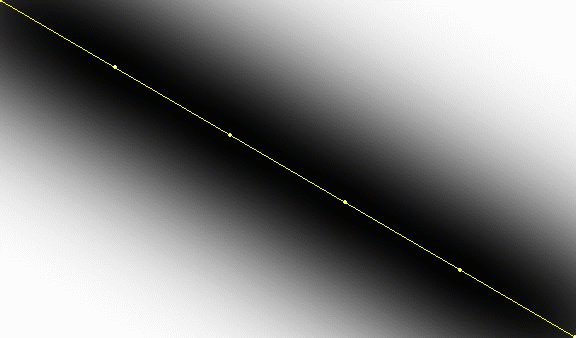Fuzzyfied Straight Line
$
\def \hieruit {\quad \Longrightarrow \quad}
\def \norm {\frac{1}{\sigma \sqrt{2\pi}} \; }
\def \half {\frac{1}{2}}
$
Three steps forward, two steps backward. We are going to compare some fuzzyfied
continuous entities with their discrete counterparts and see if it is possible
to distinguish between the two. The two obvious candidates are a straight line
and a circle. We start with the line. The equations of an ideal straight line
are:
$$ \left\{ \begin{array}{l}
x = a + \cos(\phi)\,t \\ y = b + \sin(\phi)\,t
\end{array} \right.
$$
Here $(x,y) =$ plane coordinates, $\phi =$ angle with horizontal (constant),
$(a,b) =$ point on this line, $t =$ running parameter. All numbers real
valued by default.
Lemma.
$$ [x-a-\cos(\phi)\,t]^2 + [y-b-\sin(\phi)\,t]^2 \\
= [t - \{\cos(\phi) (x-a) + \sin(\phi) (y-b)\}]^2
+ [\sin(\phi) (x-a) - \cos(\phi) (y-b)]^2
$$
Proof.
$$
[x-a-\cos(\phi)\,t]^2 + [y-b -\sin(\phi)\,t]^2 \\
= (x-a)^2 + (y-b)^2 + t^2 - 2 [\cos(\phi) (x-a) + \sin(\phi) (y-b)] t \\
= t^2 - 2 [\cos(\phi) (x-a) + \sin(\phi) (y-b)] t
+ [\cos(\phi) (x-a) + \sin(\phi) (y-b)]^2 \\
- [\cos(\phi) (x-a) + \sin(\phi) (y-b)]^2
+ (x-a)^2 + (y-b)^2 \\
= [t - \{\cos(\phi) (x-a) + \sin(\phi) (y-b)\}]^2
- \cos^2(\phi) (x-a)^2 - \sin^2(\phi) (y-b)^2 \\
- 2 \cos(\phi) (x-a) \sin(\phi) (y-b) + (x-a)^2 + (y-b)^2 \\
= [t - \{\cos(\phi) (x-a) + \sin(\phi) (y-b)\}]^2
+ \sin^2(\phi) (x-a)^2 + \cos^2(\phi) (y-b)^2 \\
- 2 \sin(\phi) (x-a) \cos(\phi) (y-b) \\
\hieruit [x-a-\cos(\phi)\,t]^2 + [y-b-\sin(\phi)\,t]^2 \\
= [t - \{\cos(\phi) (x-a) + \sin(\phi) (y-b)\}]^2
+ [\sin(\phi) (x-a) - \cos(\phi) (y-b)]^2
$$
Quite Easily Done. The (Gaussian) fuzzyfication of an ideal straight line will
now be defined as follows.
$$
L(x,y) = \norm \int_{-\infty}^{+\infty} e^{-Q(x,y,t)/2} dt \\
\mbox{where}
\quad Q(x,y,t) = \{[x-a-\cos(\phi)\,t]^2 + [y-b-\sin(\phi)\,t]^2\}/\sigma^2
$$
With help of the lemma we find for the integral:
$$
= e^{-\half [\sin(\phi) (x-a) - \cos(\phi) (y-b)]^2/\sigma^2} \norm
\int_{-\infty}^{+\infty} e^{-\half [t - \{\cos(\phi) (x-a) + \sin(\phi) (y-b)\}]^2
/\sigma^2} dt \\
\hieruit L(x,y) = e^{-\half [\sin(\phi) (x-a) - \cos(\phi) (y-b)]^2/\sigma^2}
$$
The argument in the latter exponent is recognized as the normal equation of the
straight line: $\,\sin(\phi) (x-a) - \cos(\phi) (y-b)=0\,$, with a normal vector
$= (\sin(\phi),-\cos(\phi)\,$.
The result is a function with values between 0 and
1: sort of probability. Thus a thicknessfor the fuzzyfied line may be
defined as being $\sigma$. Numerical experiments may be carried out now and it
is for you to decide whether it's possible to see any difference between the
fuzzyfied continuous and the continuized discrete (bell shapes at yellow dots):


